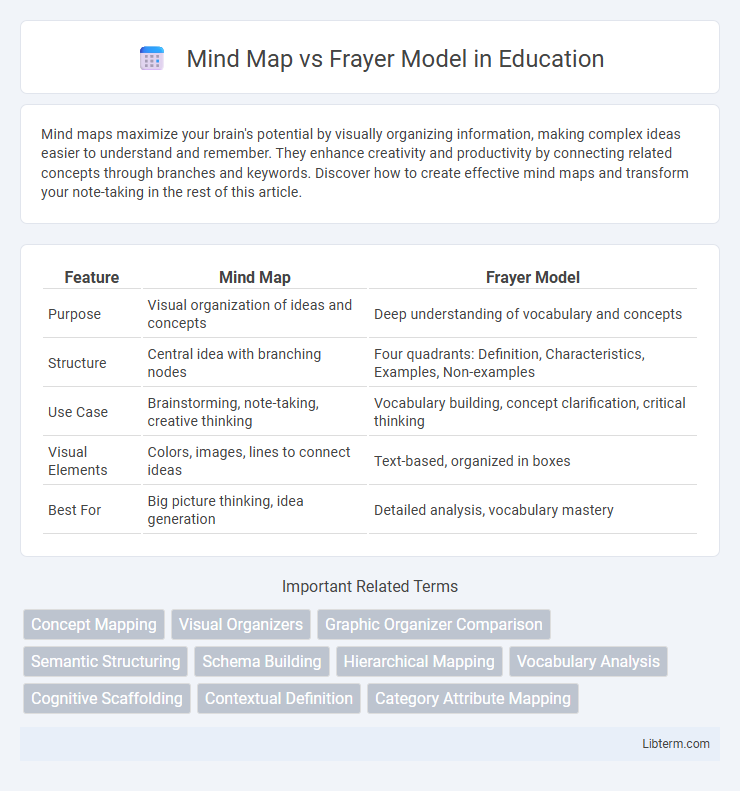Mind maps maximize your brain's potential by visually organizing information, making complex ideas easier to understand and remember. They enhance creativity and productivity by connecting related concepts through branches and keywords. Discover how to create effective mind maps and transform your note-taking in the rest of this article.
Table of Comparison
| Feature | Mind Map | Frayer Model |
|---|---|---|
| Purpose | Visual organization of ideas and concepts | Deep understanding of vocabulary and concepts |
| Structure | Central idea with branching nodes | Four quadrants: Definition, Characteristics, Examples, Non-examples |
| Use Case | Brainstorming, note-taking, creative thinking | Vocabulary building, concept clarification, critical thinking |
| Visual Elements | Colors, images, lines to connect ideas | Text-based, organized in boxes |
| Best For | Big picture thinking, idea generation | Detailed analysis, vocabulary mastery |
Introduction to Graphic Organizers
Graphic organizers such as Mind Maps and the Frayer Model enhance comprehension by visually structuring information to support learning. Mind Maps centralize a main concept with branching ideas, enabling creative thinking and idea generation, while the Frayer Model organizes vocabulary or concepts into definitions, characteristics, examples, and non-examples for deeper understanding. Both tools are essential in education for improving memory retention and facilitating clearer communication of complex topics.
What is a Mind Map?
A Mind Map is a visual diagram used to organize information hierarchically, starting from a central concept and branching out into related topics and subtopics. It enhances memory retention and creativity by linking ideas with keywords, images, and colors, making complex information easier to understand. This tool is widely used in education, brainstorming sessions, and project planning for its ability to stimulate both analytical and creative thinking.
What is the Frayer Model?
The Frayer Model is a graphical organizer used for vocabulary building and concept clarification, featuring four quadrants labeled Definition, Characteristics, Examples, and Non-Examples. It helps students deepen understanding by categorizing information around a central concept and distinguishing it from related ideas. Unlike Mind Maps, which visually organize ideas hierarchically, the Frayer Model focuses on in-depth analysis of a single term or concept.
Key Features of Mind Maps
Mind maps organize information visually by placing a central idea at the center and branching out into related subtopics, enhancing memory retention and creativity. They use colors, images, and keywords to create associations, making complex concepts easier to understand and recall. Mind maps support flexible, non-linear thinking, ideal for brainstorming and problem-solving tasks.
Key Features of the Frayer Model
The Frayer Model is a graphic organizer that emphasizes defining a concept by categorizing its definition, characteristics, examples, and non-examples, improving vocabulary comprehension and critical thinking skills. This model encourages deeper understanding by breaking down complex ideas into specific components, which aids retention and application in various educational settings. Unlike a Mind Map that visually connects ideas and subtopics, the Frayer Model's structured four-quadrant approach focuses on clarity and precision in mastering single key concepts.
Mind Map vs Frayer Model: Visual Structure
Mind Maps use a radial structure with a central concept branching out into related ideas, promoting nonlinear thinking and easy visualization of connections. The Frayer Model employs a four-quadrant layout focusing on definition, characteristics, examples, and non-examples, enhancing detailed understanding of a single concept. Mind Maps excel in illustrating relationships across multiple ideas, while the Frayer Model provides in-depth analysis within a structured, compartmentalized format.
Applications in Education
Mind maps enhance creativity and memory retention by visually organizing concepts and their relationships, making them ideal for brainstorming sessions and note-taking in various subjects. The Frayer Model supports vocabulary development and conceptual understanding through definition, characteristics, examples, and non-examples, which is particularly effective for language arts and science education. Both tools promote critical thinking, but mind maps are more flexible for broad content exploration, while the Frayer Model provides a structured approach to mastering specific terms and ideas.
Strengths and Limitations
Mind maps excel at visually organizing ideas, enhancing creativity, and making complex information easier to understand through hierarchical relationships but can become cluttered with excessive details. The Frayer Model strengthens concept comprehension and vocabulary acquisition by breaking down definitions, characteristics, examples, and non-examples, making it particularly useful in educational settings but may limit broader idea connections due to its structured format. Both tools support learning and problem-solving but differ in flexibility and depth, where mind maps promote expansive brainstorming while the Frayer Model emphasizes precise concept clarification.
Choosing the Right Tool for Learning
Mind maps excel at visualizing complex relationships and enhancing creativity by organizing ideas around a central concept, making them ideal for brainstorming and project planning. The Frayer Model emphasizes deep understanding of vocabulary or concepts through definition, characteristics, examples, and non-examples, supporting critical thinking and retention in language learning or subject-specific education. Choosing the right tool depends on learning goals: mind maps foster broad idea generation and connections, whereas the Frayer Model targets comprehension and contextual mastery of specific terms.
Conclusion: Which Organizer Suits Your Needs?
Choosing between Mind Map and Frayer Model depends on your learning goals and content complexity. Mind Maps excel in visualizing relationships and brainstorming ideas with non-linear structures, ideal for creative thinking. The Frayer Model suits vocabulary building and concept mastery by breaking down definitions, characteristics, examples, and non-examples to deepen understanding.
Mind Map Infographic

 libterm.com
libterm.com